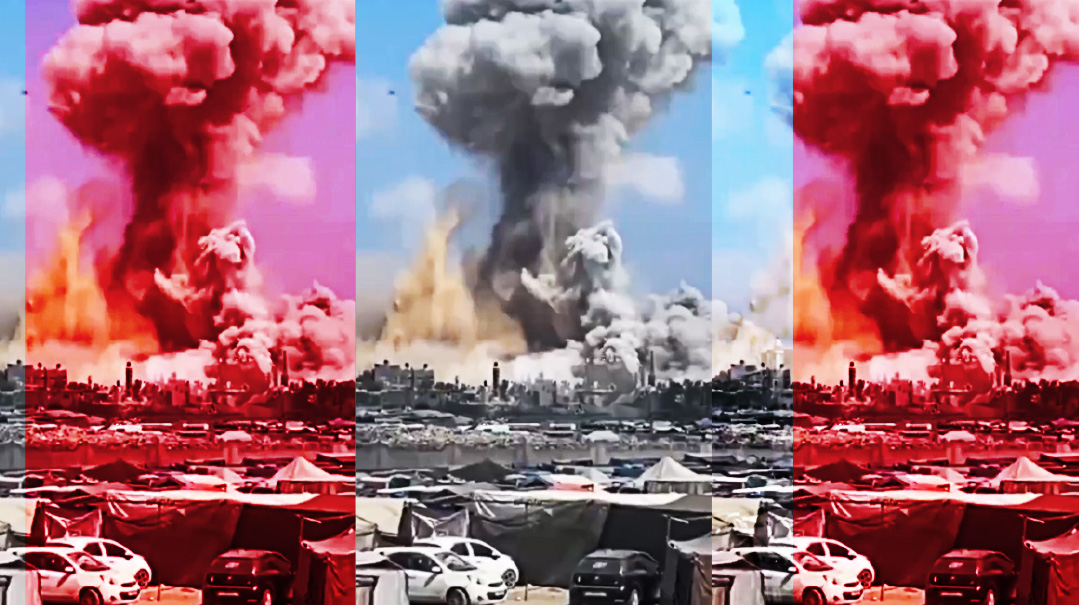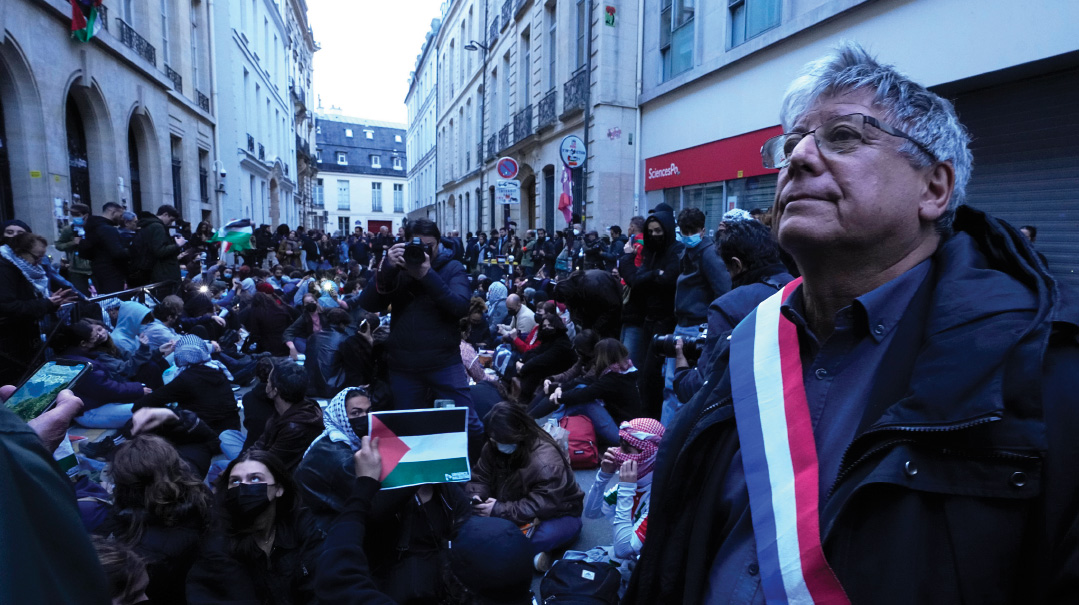Dressed To Kill

In the alleys of Jenin and beyond, terrorists can never be sure who’s signing their death warrant

It’s 5:30 a.m. on January 30, and the security cameras at Ibn Sira Hospital in the Samarian terror refuge town of Jenin don’t show anything out of the ordinary. A cluster of doctors and nurses are making early-morning rounds, and a woman in a wheelchair is accompanied by two female family members. Yet in a sudden twist, the presumed invalid, her escorts, and the medical staff reveal assault rifles and hurry to move in on their target. Ten minutes later, they’ve evacuated the premises, after having eliminated three wanted terrorists hiding out in one of the hospital’s examination rooms.
This is the modus operandi of elite commandos trained to infiltrate the heart of Arab society and seamlessly blend in. They are the “mista’arvim.”
While the video of the incident went viral, there is much more about these units that remains unknown — and that is the key to their success. Despite the fascination of media consumers with the cloak-and-dagger Mossad, the creation of these units has played a crucial role in preventing attacks, making arrests, and, of course, eliminating enemies. Their stories are no less compelling than those of the more prominent international intelligence agency, and some may even argue that it’s easier to go unnoticed on the French Riviera than in the heart of territories controlled by Palestinian terror lords.
Undercover units have been a staple of security since the pre-state Jewish defenders of Palestine. Today, like his predecessors, a mista’arev — who might belong to Duvdevan, Shaked, Shimshon, Yamas, or one of the other secret units — takes on a dual identity after grueling, intensive instruction in Arabic and Palestinian cultural nuances that teaches him how to dress, eat, speak, and even smell like the local populace. That’s in addition to stealth and anti-terrorist combat training.
While each of the units has many members, each of those teammates essentially operates alone. “Ultimately, each operative is in the field as a loner,” related N., a former member of the mista’arvim in the IDF journal Bamachaneh. “Even if there are others from his unit on the same village street, he will still be a loner.” The fear, he said, can be paralyzing. “You’re alone, in the heart of enemy territory, and the smallest misstep could lead you to be discovered.”
On the one hand, the operative lives with the constant threat of discovery by the locals, but ironically, he also lives in fear of the Israeli army. “Sometimes I would encounter a group of IDF soldiers who assumed I was a local, and maybe even an agitator,” said N. “There were situations where Israeli reservists actually chased us and beat us.”
He relates how he and another mista’arev were in a coffee house playing backgammon with the locals. Suddenly, a group of four or five soldiers, who had absolutely no idea that there were mista’arvim in the area, appeared in the room.
“I was petrified,” he recalls. “I had to remain utterly calm and hope that the soldiers would not reach us. After all, I couldn’t simply go over to them in the middle of Jenin and call out, ‘Hey, Itzik, what’s doing? I’m at work right now.’ So I just sat there and tried to remain calm.” But hundreds of hours of training came back to him in an instant. “I pretended to be the village madman. I started shouting like a crazy person and foaming at the mouth. I wanted to make sure that the officer leading the tour, who was certainly familiar with the local parlance, would tell his soldiers, ‘Leave him alone, he’s mentally disturbed.’
“Generally, though, the most important thing is to know how to blend in. The last thing you want to do is attract attention. Once, I bought ice cream along with another comrade, but instead of throwing down the wrapper, I kept it on the stick and slid the ice cream through it.
“Suddenly my buddy hissed, ‘What are you doing?! Do you think you’re in the middle of Tel Aviv?’ ”
A mista’arev will often know the Palestinian town he’s stationed in better than his own neighborhood. Are there turnoffs or alleys on a given street? Is there roadwork? Are there no-entry signs, speed bumps, potholes, or other places where a car could accelerate or be forced to slow down? Terrorists are constantly on the move. They relocate from one apartment to another and switch cars without warning.
“We need to figure out the best possible moment to capture our quarry,” said N. “To do that, you not only need top-notch intelligence, but also to think exactly as if you were in his head. You need to anticipate his next step.”
With a British Accent
How did a tiny peripheral unit that predated the establishment of the State of Israel and initially comprised just four men whose sole asset was their Sephardic origin become a key player in the fight against terrorism? How did a group of soldiers tasked with intelligence gathering evolve into one of the most precise and effective assault tools of the Israeli army? And, most importantly, in an era when any overt military offensive faces scrutiny from the international community, can these elite units become the key to dismantling the enemy from within?
The word “mista’arvim” is the Hebrew adaptation of its original Arabic counterpart, “musta’ribeen.” Essentially translating to “those who want to pass as Arabs,” this term was bestowed upon 15th-century Sephardic Jews who aimed to seamlessly blend into the Arab countries where they resided. Five centuries later, motivations may have changed, but the spirit of the word remains the same.
As is often the case in the history of Israeli security forces, institutions and departments can often be traced back to the pre-State era. In 1940, amid the global upheaval of World War II, the British Special Operations Executive leaders deemed it necessary to have individuals reporting the clandestine whispers in Arab countries. For this mission, they joined forces with the paramilitary Haganah (the forerunner of the IDF), which committed to providing personnel for the operation. The logical choice was to select individuals with roots in these locations from within their ranks.
And so, a small group of Sephardic youths took up the task. Jack Saad and Yitzchak Yaffe were dispatched to Damascus, Shalom Muaz and Shlomo Tzalach to Beirut, and Yosef Costica to Tripoli. Their tasks were confined to gathering classified information that would later reach the British regarding movements in Lebanon and Syria — territories the English crown sought to control. They were the first mista’arvim.
Following these individual missions, the first proper unit was established in 1941, under the umbrella of the British Empire. The hubs of heightened activity were then the Syrian cities of Damascus and Aleppo, but their activities were restricted to basic-level information and espionage. However, significant changes were on the horizon.
Blending In
The transition from what was then known as “the Syrian Department” to a more professional entity was orchestrated by three individuals. Yigal Alon, who would become an IDF general and a central figure in Israeli politics, assumed leadership of the unit in 1942, recognizing the need to expand its ranks and enhance training. The other two key figures were Yerucham Cohen, who would later lead the “Arab Platoon” of the Palmach, the pre-State fighting force of the Haganah, and Shimon “Samaan” Somech, who would later have a distinguished career in the Mossad and was responsible for recruiting the renowned spy Eli Cohen.
The initial challenge faced by the leaders of the emerging Arab Platoon was recruiting personnel. Ashkenazi Jews were ruled out, and Yerucham Cohen, of Yemenite origin, aimed to find Sephardic Jews with a solid educational background. However, it proved difficult to locate Mizrachi Jews meeting these criteria, as the British and the leaders of the Yishuv failed to intergrate these Jews into higher educational institutions.
The only individuals who fit the necessary physical profile necessary for the unit were young people from the most marginalized and impoverished neighborhoods of the Yishuv, compelled to work from a young age and unable to pursue formal education. In the end, this actually turned out for the best, because what these potential recruits lacked in formal education, they compensated for in motivation — they were thirsty for achievement and acknowledgment and wanted to prove to the predominantly Ashkenazi leadership of the Palmach that they could achieve what others couldn’t. To demonstrate their greater commitment to the cause than that of their European-descended leaders, members of the Arab Platoon, for one thing, would refuse to take the rest days that others enjoyed every three weeks.
The Ashkenazi-Sephardi tension persisted to the extent that the informal name given to the unit by Palmach leaders was the “Shachar Department.” Romantics might believe it referred to “dawn.” However, it is known that it was used in reference to the word “shachor” or “the blacks.” Nevertheless, time would reveal that only they could carry out these types of operations.
While the missions included actions in Baghdad and Damascus, the focus was primarily on areas under Arab control in Eretz Yisrael. The Cohen-Somech duo, which led the group after Alon’s departure, deemed it essential for unit members to blend in with the Arab population. Many mista’arvim were compelled to enlist for months in basic tasks such as loading bags at the port, just to learn the slang, modes of dress, and even conversation topics of the average Arab on the street. Somech and Cohen also mandated participants to study the Quran and participate in Friday prayers at various mosques in the area.
By this point, unit members were no longer merely “information transmitters.” The unit closely investigated leaders of Arab cells, worked in coordination with Palmach military forces, pilfered weapons from the British, and, if necessary, got involved in eliminations.
Vanishing Acts
The mista’arvim proved indispensable during the conflicts with Arab countries at the time of Israel’s independence. Months before the declaration, military leaders Yitzchak Rabin (who would later become prime minister) and Yigal Alon sent a group of mista’arvim disguised as shepherds to the border territory with Syria.
These seemingly simple rural laborers infiltrated Syrian territory and reached Damascus, obtaining crucial information for the impending clash with Syrian forces. Alon himself would later assert that sending this small group of shepherds was more decisive for the war “than sending an entire battalion to Damascus.”
The central figures of the Arab Platoon from 1945 to 1950 became legends within the community of Israeli intelligence operatives. Among them, notable individuals included Yakubah Cohen (a member of the “shepherds” group and a future intelligence operative serving in Syria, Jordan, Iraq, Egypt, and Iran); Shimon Choresh (who operated undercover in Syria and Turkey, joined the ranks of the Mossad, and eventually dedicated himself to training future agents for covert operations in Arab countries); Jamile “Gamliel” Cohen (also a future Mossad operative); Yitzchak Shushan (considered the unit’s foremost expert on Islam-related matters who continued his career in the Mossad); and Chabakuk Cohen (a central figure who died during an operation against Jordanian agents in 1951).
They even orchestrated the establishment of a hidden mista’arvim headquarters in the heart of Beirut. From there, with some posing as local taxi drivers, they gathered invaluable information for the nascent IDF forces.
Another hot spot during that time was Haifa, where the heroic operation involving Yakubah Cohen and Yitzhak Shushan is still remembered. IDF sources had discovered that Arab terrorists were planning a car bomb attack using an automobile temporally parked in a mechanic’s shop on Nazareth Street in the port city. The terrorists planned to detonate it in Hadar HaCarmel, Haifa’s commercial center.
Disguised and flaunting his fluent Arabic, Yakubah brought a malfunctioning car to the workshop, insisting that the mechanics fix it right away. His insistence was so strong that the mechanics (aware they had to attend to “other matters”) went to fetch the manager. In that split-second, Yakubah activated the explosive’s charge and escaped toward the exit, where Shushan awaited him for a getaway. The detonation resulted in 30 casualties, including the terrorists, but prevented a catastrophe of much more terrible proportions.
Contrary to expectations, however, the Arab Platoon would vanish soon after the establishment of the State of Israel, and it would take another 30 years for similar units to renew such operations.
Engaging the Intifada
It’s no secret that the Arab-Israeli conflict has never been on pause, and therefore, there have always been members posing as Arabs in order to gather information or execute orders.
In 1970, Ariel Sharon established the Rimon Unit, tasked with combating terrorism in the Gaza Strip, where undercover strategies were imperative. In 1974, the National Counter Terror Unit (better known by its Hebrew initials, “Yamam”) was established, and it continues to employ mista’arvim to this day.
However, by the mid-’80s, the escalated tensions between the Jews and the Palestinians demonstrated the need to revitalize mista’arvim units: There was too much information not being acquired, and it could only be gathered from within.
In 1986, then-General Ehud Barak (who would later become prime minister for one year) deemed it crucial to create the “Duvdevan” unit.
“I want a unit whose members look like Arabs, speak like Arabs, and ride bikes in the alleys of Shechem as if they were on Dizengoff Street in Tel Aviv,” Barak explained at the time. “People who can operate with partial cover to reach operational contact without the need for large forces and early exposure.”
It was none too soon: A year later, the Intifada was in full force.
In fact, Barak himself was a mista’arev when he was younger. In the 1973 Operation Spring of Youth, aimed at the elimination of three PLO Fatah leaders following several terrorist attacks, Ehud Barak, commander of the Sayeret Matkal special forces, landed on the Beirut beach with the first soldiers, and entered the city disguised as a young woman.
That same night, together with his team, he eliminated three high-ranking members of the Palestine Liberation Organization.
In 1991, officer Eli Abram, then part of the National Counter-terror Unit, created the “Mista’arvim Unit” or Yamas, according to its Hebrew acronym, which is officially under the purview of the Border Police. Abram was killed in Jenin during an operation, but he became an icon for Israeli counter-terrorism forces and laid the groundwork for the renewed prestige these elite groups hold today.
Yamas forces are credited with capturing hundreds of Hamas fugitives and low-level operatives and killing dozens of terrorists in the prevention of suicide bombings and other attacks. Yamas, which works in conjunction with the Shin Bet, specializes in sniper combat in the southern region and infiltration in Judea and Samaria. In the Jerusalem region — which is trickier, because the two populations are so close, and most Arabs are Israeli citizens — operatives are used to blend into the local Arab population.
Recognition and Revenge
Today, hundreds of young individuals apply to join elite forces, whether in one of the three mista’arvim units under the Border Police, or in the Duvdevan unit. However, only about five percent of applicants are accepted.
To qualify for entry, one must have served time in other areas of the army, undergo an intensive (even by IDF standards) four-month training program, another three months of advanced infantry training, two months of specialized counter-terrorism training, and four months of training in personal camouflage techniques, the study of Islam and Arab traditions, Arabic slang, and in blending into the Arab streets. After completing all these requirements, only the most proficient are accepted, ready and willing to embark on a new, chameleon-like life.
Mista’arvim are trained to burst into populated enclaves if need be and to overcome armed terrorists with speed and surprise. Operators — who have undergone psychological testing to make sure they’re steely and 100 percent stable — are expert marksmen and masters at krav maga (Israeli-style martial arts). And today they’re equipped with sophisticated communications equipment that enables them to stay connected to their home base.
The results achieved through improvements in training are evident. For example, delivery trucks are no longer allowed to enter the most dangerous areas of Jenin, on suspicion that there could be a mista’arev infiltration. In fact, terrorists have killed members of their own ranks, mistaking them for undercover agents.
Still, covert assassination operations like the one at the Ibn Sira Hospital send a clear message: It doesn’t matter where they live. It doesn’t matter where they hide. Sooner or later, those who have shed Jewish blood will be hunted to face justice. Perhaps not today, and maybe not tomorrow, but terrorists realize they can never relax.
Because perhaps the friendly grocer, the barber they discuss politics with, or even the neighbor who is always so pleasant — any of them could be the one signing their death warrant.
(Originally featured in Mishpacha, Issue 998)
Oops! We could not locate your form.







